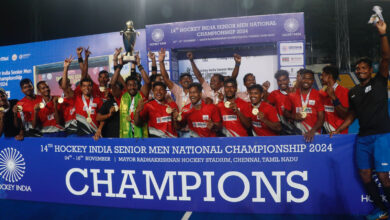1054 dot balls in 7 games: How women cricketers need to change and hit the ground running

The BCCI might have been blamed in the past for the lack of focus on women’s cricket and they certainly need to walk the talk but the problem goes beyond them. India can blame the misfortune of a no-ball against South Africa for their ouster, but they also contributed to their own downfall.
Archaic batting templates, worrying number of dot balls, frequent changes in the playing XI, lack of athleticism and some uninspiring captaincy meant last edition’s losing finals failed to qualify for the semi-final stage.
Update: India’s campaign in the #CWC22 comes to an end. South Africa needed 1 off the final ball and managed to score the winning run.
Details ▶️ https://t.co/BWw8yYwlOS#TeamIndia | #CWC22 | #INDvSA pic.twitter.com/1EoGNKtujO
— BCCI Women (@BCCIWomen) March 27, 2022
Old template
Other top teams like Australia, England and South Africa have moved on from the outdated approach to white ball cricket. The Indian team have stepped on to that path, but are moving too slowly towards playing this new brand of cricket.
Sample their chase against New Zealand, who set a 261-run target. India played out 85 dot balls in the first 20 overs; all in all, they remained mute for 153 balls. Not that this is just a World-Cup aberration. Last June, they played out 181 dot balls in a game against England. The alarm bells were ringing but it appears no one was lening.
Former captain Anjum Chopra reckons India lacks the ammunition and the expertise in strike rotations. “Top teams have certainly moved on regarding big-hitting and strike rotations. In the case of India, my answer will be both Yes and No.
“Yes, because we are still trying to get into that template, where we can score 280 plus consently or chase down big totals. We are still trying to figure out and be consent about reaching these scores whether batting or chasing,” Anjum Chopra told The Indian Express.
“No, because strike rotation and big-hitting has been the challenge for many years for India now. Big-hitting has slightly improved, but that power-hitting in the last five and seven overs is still missing. I guess we are still moving slowly and steadily towards the brand of cricket,” she added of the glacial pace of upgrading.
India’s biggest nemesis at the World Cup was their sluggish approach. (Twitter/ BCCI Women)
Dot-ball problem
India’s biggest nemesis at the World Cup was their sluggish approach. Overall, they played 1054 dot balls in the seven matches. In other words, they played almost three ODIs without scoring a single run. Australia, the most dominating side of the tournament, consumed 959 dot balls in the round-robin league, 95 fewer than India. Interestingly, when it comes to power-hitting, India leads the six-hitting chart. Their batters struck 15 sixes, the most in the tournament. But other scoring shots were found wanting.
Anjum, who was the commentator with the host broadcaster during the World Cup, feels that Indian batters need to update their skills.
“The approach is straightforward. Reduce the dot ball percentage. The Indian team plays a lot of dot balls, and there is too much reliance on dead defence shots. I guess the few aspects on which Team India must work are rotation of strike, playing with soft hands, improving the running between the wickets, dropping the ball, and running for a quick single. These skills have to be practiced and learned very seriously. The Indian team has stroke players, but they cannot rotate strike at will. That skill has to be incorporated whether they are setting the target or chasing,” said Anjum.
Sneh Rana of India celebrates. (AP/PTI)
Lack of athleticism
India’s ground fielding throughout the event was far from impressive. They fumbled and dropped regulation chances. There was room for improvement in running between the wicket too. Senior batters were struggling to run twos and threes. Shafali Verma’s run out in the crucial match against South Africa highlighted the problem.
“Look, the Indian team is obviously working on the fitness aspect. It is not that they are unfit players, but fitness and fielding are something you can always work on. Even if you are super fit and a gun fielder, there’s always a scope for improvement, sky’s the limit, and there is no benchmark. Every player has to improve individually, and the results will be out there at the park,” said Anjum.
Back-to-back defeats against England and Australia does not bode well for India Women. (Twitter/BCCI Domestic)
Did they miss Jemimah, Pandey?
The omission of Jemimah Rodrigues and experienced pacer Shikha Pandey from the World Cup has raised eyebrows. But they were ignored due to their lack of form. Jemimah lost her place in the ODI side after a poor run in England in July, and while her stellar performance in the Hundred helped her make a comeback in the shortest format, it wasn’t enough to book a place at the World Cup.
“I still feel Jemi should have been here even if not in 15, then in 18 for sure, but having said that, I don’t think she would have found a place in the playing eleven. Yastika Bhatia absolutely grabbed the opportunity while batting at 3. Same goes for Shikha. She would have been definitely a good addition if she had been in the best form, bowling alongside Jhulan Goswami. You never know, the experience of Jhulan, which was missing in the tournament and maybe the experience of Shikha could have come in. But for that, you have to drop Meghna Singh, who has done well in the last five – seven months,” she said.
On Poonam Yadav’s lack of game time, Anjum said: “The Indian team was happy with the three regular spinners (Sneh Rana, Deepti Sharma and Rajeshwari Gayakwad), and for Poonam Yadav to come in, they had to drop a bowler or an all-rounder, but that would have changed India’s balance.”
Shafali Verma is special – 4,0,2,4,4,4 in last 6 balls. #CWC22 pic.twitter.com/bdU26UVkkC
— Johns. (@CricCrazyJohns) March 27, 2022
Dropping Shafali
Before the tournament, Indian captain Mithali Raj was all praise for Verma. Although the flamboyant batter was going through a lean run, she is someone who can change the course of the game in a few overs. Shafali was dropped for three straight games after her failure in the opening match against Pakan. She showed a glimpse of her excellence against South Africa and how she toyed with Shabnim Ismail, the tournament’s fastest bowler.
“Dropping Shafali Verma after the first match was absolutely not justified. It was a high-pressure game for a youngster coming in and playing her first World Cup. You can expect a false shot coming from a player but dropping Shafali and not backing her throughout the World Cup sends out a wrong signal. If team management is dropping any player, it gives you the signal that you are out of form and the team is looking beyond you,” says Anjum.
! 👏 👏@mandhana_smriti shares her Player of the Match award with fellow centurion & #TeamIndia vice-captain @ImHarmanpreet ! 🙌 🙌 #CWC22 | #WIvIND
Scorecard ▶️ https://t.co/ZOIa3KL56d pic.twitter.com/8REiQMSLke
— BCCI Women (@BCCIWomen) March 12, 2022
Not using Harmanpreet’s bowling
Harmanpreet scored 318 runs in the tournament and was the second-highest run-getter for India after opener Mandhana (327 runs). But surprisingly, she didn’t bowl until the last game against South Africa.
The India vice-captain provided India with the much-needed breakthrough with the wicket of the tournament’s leading run-scorer Laura Wolvaardt, and later she trapped South African skipper Sune Luus.
“Harmanpreet not bowling was another mystery. Why was Harmanpreet not used throughout the tournament? Even against South Africa, when all the resources were exhausted then, she was thrown the ball, and there again, she bowled eight overs. I wish she could have bowled her full quota, and who knows, the Indian team might have ended up on a winning side. She was under bowled. It was like under utilisation of their quality resources the Indian team,” lamented Anjum.
The coach conundrum
It has been musical chairs when it comes to the coaches. Four coaches have been changed in the past five years.
Former Baroda cricketer Tushar Arothe, who led the team to the final in the 2017 World Cup, stepped down a year later, five months prior to the Women’s World T20. One of the reasons for the alleged discord was Arothe’s training methods.
Two mandatory practice sessions of roughly two and a half hours each in the morning and late afternoon and an optional afternoon session strained the relationship between the coach and senior players. BCCI received complaints from senior players, especially T20 skipper Harmanpreet Kaur, about his training methods.
Ramesh Powar, the current coach of the Indian women’s team, replaced Arothe in August 2018. A few months later, Powar was sacked from the same position following a fallout with Mithali.
In turn, Mithali had then accused the former India cricketer of bias after the Harmanpreet-led T20 team dropped the veteran batter for the all-important World Cup semi-final against England.
In December 2018, former India opener W V Raman was appointed head coach. During his stint, India finished runners-up at the T20 World Cup in 2020.
In May 2021, in a surprising move as the team seemingly did well under him, Raman was not retained as the head coach of the senior women’s team the Cricket Advisory Committee (CAC), which picked Ramesh Powar for the job.
Going forward
The World Cup exit may be a bitter pill to swallow, and there might be changes in the coaching staff with the T20 World Cup scheduled to be played in South Africa next year from February 9 to 26. A full-fledged women’s IPL from next year is a possibility, and it can lead to a radical shift in women’s cricket.
However, Anjum sees it differently. For her, the present should be sorted first before thinking about the future. “The present is absolutely essential. There is a T20 World Cup scheduled to be played next year; I am eagerly looking to see how this Indian team will go forward with new support staff and coaches coming in,” she signed off. If the present is neglected, what hope lies for the future?







